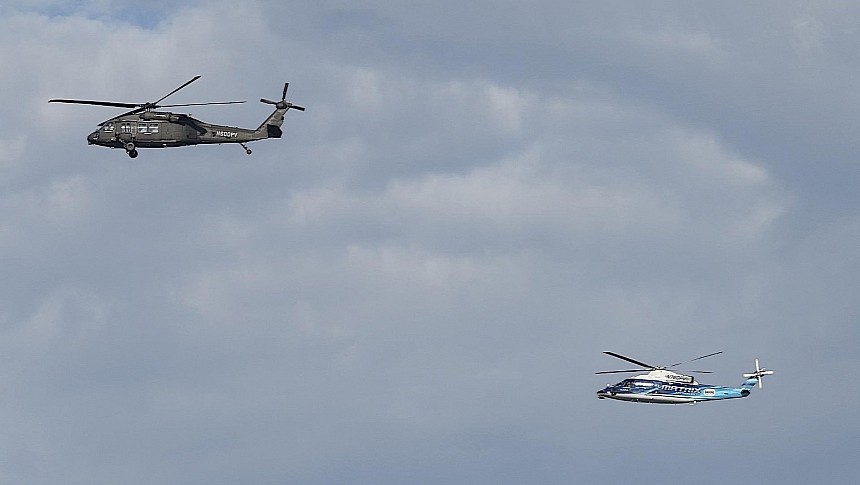If you happened to be in the general area of Long Island Sound in late October last year, you might have been witness to a pair of helicopters performing all sorts of maneuvers in the sky. You might have thought nothing of it, but here's something to get you thinking: the two helicopters were flying on their own.
Today's aircraft are for all intents and purposes autonomous, as they conduct most of the flight from origin to destination on their own. Most of them however do not have the capability to take off and land on their own, let alone avoid hazards in the sky if the need arises. The two helicopters I mentioned above, however, do.
The first is the Sikorsky Autonomy Research Aircraft (SARA). We're talking about a modified S-76B medium-size rotorcraft, specifically altered to run an autonomous system called Matrix. That's a hardware and software suite that makes aircraft operation easier for a pilot, but can as well fly itself if that's requested.
The second helo is something DARPA calls the Optionally Piloted Vehicle. It's a military Black Hawk equipped with the same Matrix system that flew for the first time, with no pilot on board, back in 2022.
The two helicopters got together three months ago (but only last week we got word of it) in Long Island Sound to attempt something that was never attempted before: fly at one another using collision avoidance software designed by NASA.
More to the point, no less than five software suites developed by NASA were loaded into the helicopters and tied to the Matrix in a bid to see whether they gain the ability to detect and avoid threats.
The threats to the two aircraft were not limited to themselves but included no less than 150 virtual aircraft and their flight plans introduced by means of coding into SARA's and Black Hawk's brains.
We're told the software that powered the helos performed flawlessly, making adjustments on its own to altitude, speed, and direction in a bid to avoid collisions with each other and other virtual presences in the sky.
The teams present at Long Island Sound (meaning people from Sikorsky, NASA, and DARPA) ran no less than 12 flights with the two helicopters, covering 70 maneuvers and achieving a total of 60 flight hours during the procedures.
Worth noting is that even though the helicopters generally flew themselves, human pilots were on board each one to supervise. That not only helped with the safety of the flights but also evaluated how human beings interact with autonomous systems.
The tests were conducted not to benefit the military solely but the civilian world as well. The collision avoidance software supplied by NASA is the space agency's attempt at creating the framework needed for air taxis to succeed. There are even plans to share the findings of these and upcoming tests with the Federal Aviation Administration (FAA), which should allow the agency to "introduce Advanced Air Mobility systems into the national airspace."
The first is the Sikorsky Autonomy Research Aircraft (SARA). We're talking about a modified S-76B medium-size rotorcraft, specifically altered to run an autonomous system called Matrix. That's a hardware and software suite that makes aircraft operation easier for a pilot, but can as well fly itself if that's requested.
The second helo is something DARPA calls the Optionally Piloted Vehicle. It's a military Black Hawk equipped with the same Matrix system that flew for the first time, with no pilot on board, back in 2022.
The two helicopters got together three months ago (but only last week we got word of it) in Long Island Sound to attempt something that was never attempted before: fly at one another using collision avoidance software designed by NASA.
More to the point, no less than five software suites developed by NASA were loaded into the helicopters and tied to the Matrix in a bid to see whether they gain the ability to detect and avoid threats.
The threats to the two aircraft were not limited to themselves but included no less than 150 virtual aircraft and their flight plans introduced by means of coding into SARA's and Black Hawk's brains.
We're told the software that powered the helos performed flawlessly, making adjustments on its own to altitude, speed, and direction in a bid to avoid collisions with each other and other virtual presences in the sky.
The teams present at Long Island Sound (meaning people from Sikorsky, NASA, and DARPA) ran no less than 12 flights with the two helicopters, covering 70 maneuvers and achieving a total of 60 flight hours during the procedures.
Worth noting is that even though the helicopters generally flew themselves, human pilots were on board each one to supervise. That not only helped with the safety of the flights but also evaluated how human beings interact with autonomous systems.
The tests were conducted not to benefit the military solely but the civilian world as well. The collision avoidance software supplied by NASA is the space agency's attempt at creating the framework needed for air taxis to succeed. There are even plans to share the findings of these and upcoming tests with the Federal Aviation Administration (FAA), which should allow the agency to "introduce Advanced Air Mobility systems into the national airspace."













